Monthly economic brief: May 2021
The monthly economic brief provides a summary of latest key economic statistics, forecasts and analysis on the Scottish economy.
This document is part of a collection
Business Activity
Business activity fell sharply at the start of 2021 during lockdown restrictions, however it has started to pick-up as restrictions have eased.
Proportion of business trading[2]
- The introduction of lockdown restrictions in December resulted in a sharp fall in business trading from over 90% in December to around 82% in January 2021. The proportion of businesses trading remained broadly stable during lockdown and the subsequent easing of restrictions has seen the proportion rise to 94% in the first half of May.
Share of Businesses that are Currently Trading 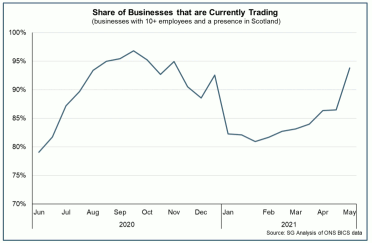
- Most sectors have seen an increase in businesses trading as restrictions have started to ease, however, some sectors are starting from very different places based on the extent to which they were impacted by restrictions.
- Consumer facing sectors such as accommodation and food services (74%) and arts, culture and recreation (85%) continue to have the lowest shares of businesses trading due to the direct impacts of restrictions. However, they had the largest proportion of businesses that resumed trading during the previous fortnight (32% and 18% respectively) as restrictions eased.
Share of Businesses that are Currently Trading, by Sector 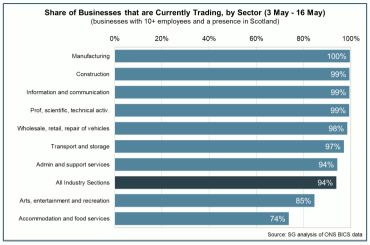
- In sectors such as information and communication, manufacturing, and construction, on average over 95% of businesses have continued trading since January reflecting the ability to continue operations through home working and/or adapting operations to restrictions in place.
Business output
- The latest Purchasing Managers Index (PMI)[3] business survey data has also started to reflect the loosening of lockdown restrictions on businesses, with the business activity index growing over March and April for the first time since September 2020, before restrictions started to tighten.
- Growth in business activity has been broad based across the services and manufacturing sectors, with the rebound in activity from recent months sharper in services reflecting the greater impact that lockdown restrictions have had in the sector, the reopening of businesses and a pick-up in client demand.
Purchasing Managers’ Index: Scottish Business Activity 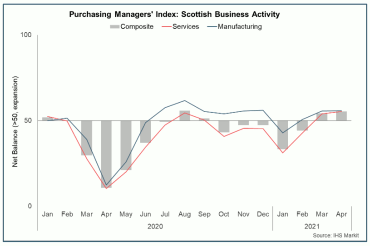
- The latest Business Insights and Conditions Survey data shows ongoing differences in turnover circumstances across sectors into the first half of May.[4]
- Overall, 36% of businesses reported having lower turnover than normal for the time of year, while 40% reported that turnover was not affected. The Accommodation and Food services sector has the highest proportion of firms (70%) reporting that business turnover is lower followed by Arts, Entertainment and Recreation (65%).
How turnover in the previous two weeks compares to what businesses would normally expect for this time of year 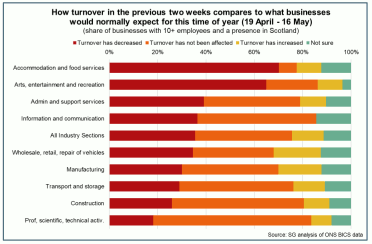
- However, the proportion of business overall reporting lower turnover has gradually fallen over March and April from over 45% in February reflecting the strengthening of activity.
- Looking to the year ahead, the PMI data sets out that business optimism remains elevated having strengthened significantly in recent months, reflecting the expectations of restrictions starting to ease and improved optimism for economic recovery.
Trade
- The pandemic and restrictions on activity had significant impacts on international demand and supply chains in 2020, which coupled with the end of the EU Exit transition period, resulted in extremely challenging trade conditions.
Scotland’s International Goods Exports 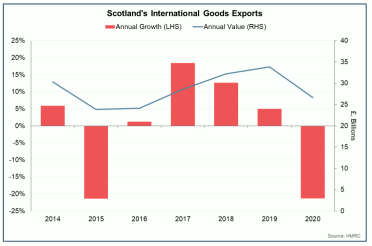
- In 2020, the value of Scotland’s annual international goods exports was £26.6 billion, down 21.3% compared to 2019, with falls across a range of commodity groups, including oil and gas exports (-40.8%), beverages (-19.8%) and food (-6.9%).[5] In terms of export destination, Scotland’s goods exports to the EU fell 18.1% to £13.7 billion while exports to non-EU countries fell 24.4% to £12.9 billion.
- More recent UK trade data[6] for the first quarter of 2021 show that following a sharp fall in UK exports in January (-29%), in which exports to the EU fell 46%, UK goods exports rebounded in February (21%) and March (21%) as some of the impacts of stockpiling at the end of 2020 faded and new trade regulations and requirements at the end of the EU transition period continued to bed in. However, despite the rebound in February and March, total exports of goods in the first quarter of 2021 remained 14% lower when compared to the first quarter of 2018, when trade was more stable and not being impacted by the pandemic or stockpiling associated with the EU transition period.
- Key exporting sectors for Scotland followed this pattern. Relative to February, monthly exports of Scotch Whisky were up 15% in March (up 20% to the EU and up 12% to non-EU), but the total for Q1 2021 was 3% lower than in Q1 2018, while total exports of fish were up 55% in March (up 67% to the EU and up 28% to non-EU), however the total for the quarter was down 34% compared to Q1 2018.
How business exporting/importing in the previous 2-weeks compares with normal expectations for the time of year 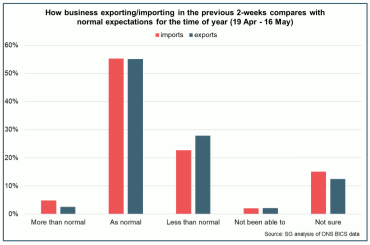
- Latest Business Insights and Conditions Survey data for the first half of May also show some further stabilisation in trade activity. 55% of respondents in Scotland were exporting as normal (up from 45% in April), while 28% were exporting less than normal (down from 34%). Importers shared a similar pattern with 55% importing as normal, while 23% had imported less than normal.[7]
Contact
Email: OCEABusiness@gov.scot
There is a problem
Thanks for your feedback